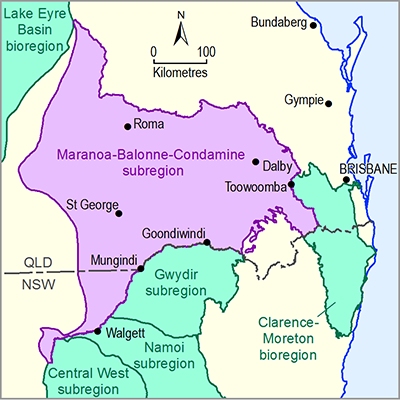- Home
- Assessments
- Bioregional Assessment Program
- Maranoa-Balonne-Condamine subregion
- 1.1 Context statement for the Maranoa-Balonne-Condamine subregion
- 1.1.7 Ecology
- 1.1.7.4 Groundwater-dependent ecosystems
The Queensland Government recently produced groundwater-dependent ecosystem mapping of the Murray–Darling drainage basin that encompasses most of the Maranoa-Balonne-Condamine subregion (DSITIA, 2012). The mapping integrated existing regional ecosystem and wetland mapping with expert knowledge to develop mapping rules to identify groundwater dependent ecosystems. There are three classes of groundwater dependent ecosystems provided by the mapping based on the surface expression of groundwater; terrestrial ecosystems dependent on the subsurface presence of groundwater; and aquifer and cave ecosystems (Figure 37). The majority of groundwater dependent ecosystems associated with channels on alluvia with seasonal baseflow or groundwater connectivity are found in the eastern and northern portions of the subregion (Figure 37). A greater proportion of the terrestrial ecosystems that potentially contain surface expressions of groundwater dependent ecosystems are located in the southern portion of the subregion along the floodplains of the Maranoa, Balonne, Moonie and Border rivers. Springs are clustered around the eastern part of the subregion, south of Toowoomba, in the northern reaches of the Maranoa and the plains near the Balonne River. Specifically the groundwater-dependent ecosystem mapping identified 14 distinct types of systems that potentially support ecosystems with some level of groundwater dependency. The hydrogeology associated with groundwater dependent ecosystems in the Queensland Murray–Darling Basin can be summarised as:
- alluvia
- those systems associated with sandstones, limestone and basalt contact zones
- permeable geologies associated with basalt
- catchment constrictions arising from a narrowing in the width and/or depth of the catchment
- Goondoola Basin, an ancient lakebed characterised by a shallow saline watertable
- inland sand ridges (DEH, 2013a).
Source data: Queensland groundwater dependent ecosystems (DSITIA, 2013).


